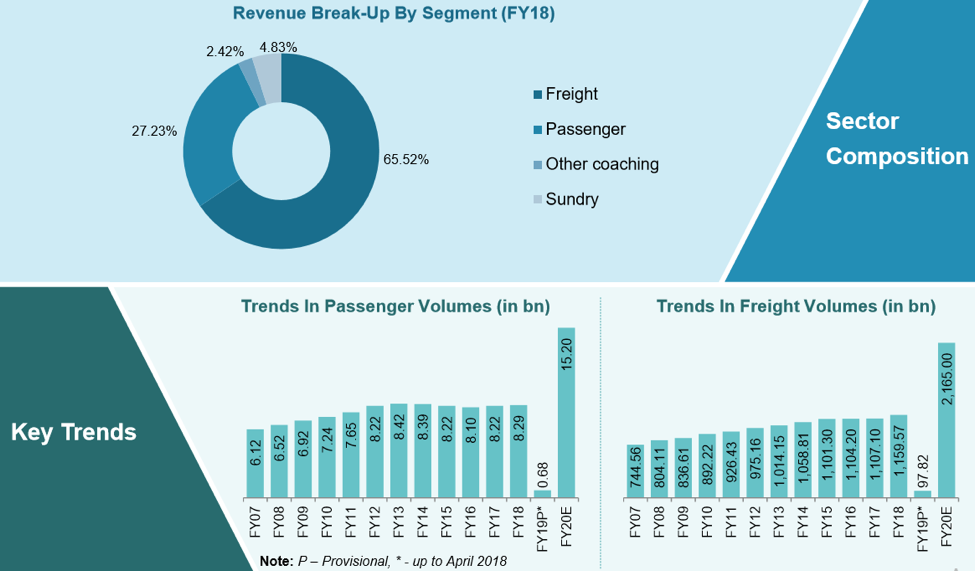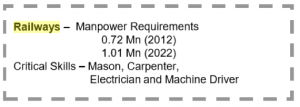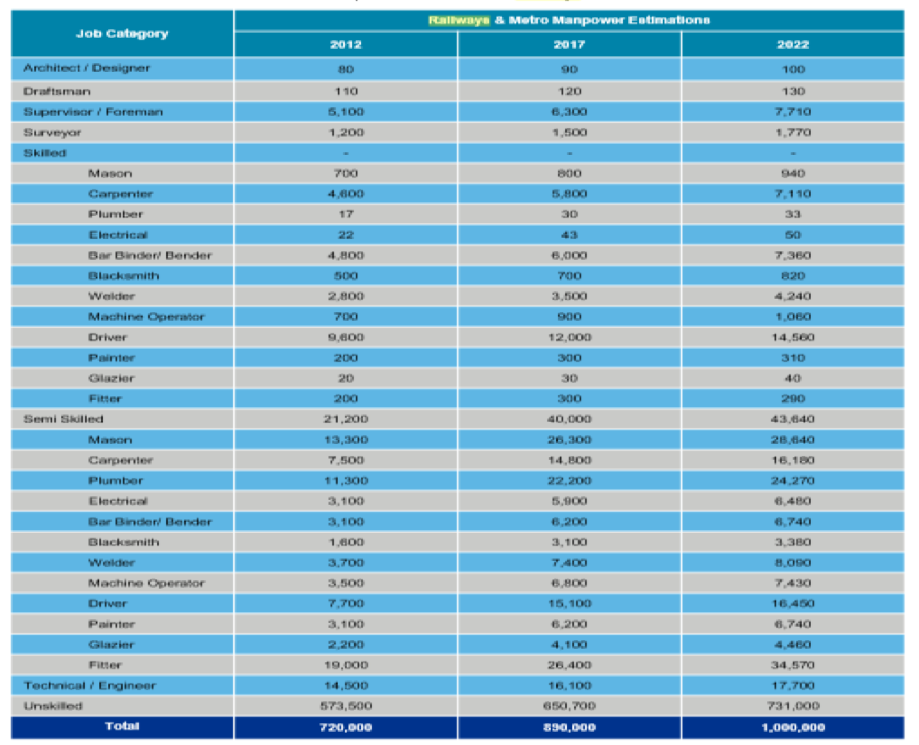How is the country’s largest employer poised to face changes and demand in skills-based training?
Indian Railways is the 4th largest rail network in the world and the largest employer in the country with 1.4 million employees. [i] The sector grew at a CAGR of 9.66 % during 2007-2018 to US$ 27.71 billion. To provide a sense of scale, the Indian railway’s crisscrossing network cuts across 115,000 kms, and supports 12,617 passenger trains and 7,421 freight trains each day from 7,349 stations carrying 23 million passengers and 3 million metric tonnes (MT) of freight daily.[ii]
With approximately 1,159.57 million tonnes of freight transported via trains in 2018 and expected to touch 2,165 million tonnes in 2020,[iii] freight takes the largest revenue slice commanding 65.52% of total revenue and grew at a CAGR of 9.83% during 2007-2018 to reach US$ 18.16 billion.ii Going forward freight will continue to dominate the Indian railway sector as the fastest growing sub-segment. Passenger traffic meanwhile was 8,286.95 million in 2018 and expected to rise to 15.18 billion by 2020.iii


Enablers & Growth Drivers
- The Railway Budget 2016-17 announced plans to set up a Railway Planning & Investment Organisation to develop a comprehensive National Rail Plan to draft medium to long term railway projects
- Setting up of the Dedicated Freight Corridor Corporation of India (DFCCIL) to oversee the planning, development and construction of six dedicated freight corridors which are expected to be game changers for rail based freight and distribution services in terms of efficiency and reduction in the cost of freight transportation. Logistics parks are also being planned alongside the freight corridors to improve the efficiency of these inter-dependent activities. Target to increase freight traffic to 3.3 billion tonnes by 2030 from 1.1 billion tonnes in 2017.
- Under Make in India, as of February 2017, plans are afoot to manufacture semi high-speed technologically advanced 160 kmph trains at the Integral Coach Factory, Chennai.
- Budget 2018-19 allocated US$ 2.21 billion for metro projects. Investment expected in metro projects as a whole by 2020 is $137 billion. With eight metro rail networks and over 24 metro projects in the pipeline, the Indian metro network is gaining ground to keep up with the rapid pace of urbanisation.
- The Railways has identified 17 sectors in its operations to allow 100% foreign or private investment in high speed railway, freight corridors, suburban lines, standalone passenger lines (hill railways), passenger terminals, bio-toilets, technological solutions for unmanned level-crossings, mechanized laundries, testing facilities, and construction of bridges.
Where Will the Jobs Be?
Indian Railways is witnessing a flurry of activity on the back of rapid urbanisation, a growing middle-class population, digitalisation of services and the importance of its freight sub-segment. As the largest employer in the country with 1.4 million employees (as of December 2016), future employment projection is in the region of around 10,000 skilled personnel to operate bullet trains and other high-speed trains being manufactured in the country. The Railway Minister Suresh Prabhu in his rail Budget 2016 speech said, “Indian Railways will generate employment of 14 crore man-days in 2018-2019.” Employment increase projection between 2017-2022 in the construction of roads and railways as a whole is 6.04 million in 2017 to 8.05 million in 2022.[iv]
Indian Railways plays a pivotal role as a feeder to a diverse set of other co-related sectors such as logistics, manufacturing and support services. A significant push to operations & maintenance (O&M) services is expected to ride the government’s focus on upgrading existing facilities including station re-development. With growing impetus on mass transit systems to support India’s heaving cities, employment opportunities in track and station maintenance, ticketing, support services such as food, porters; signaling & electrification and coach manufacturing, among others will receive a massive leg up. Also, a number of private freight terminals operated by third parties are being built along the railway network to support last mile connectivity which will see a further boost to services such as logistics and warehousing.
As in related industries such as construction, Indian Railways has an extremely high dependency on unskilled labour. According to NSSO findings over 97% of employees in the age group of 15 to 65 in infrastructure, building, construction and real estate in the country have never had any formal training. Skill India 2016-2017 Annual report estimates training needs in railways to be 0.12 lakhs between 2017-2022.
The total manpower requirement for construction and maintenance of railways is projected to be 1.01 million in 2022 which is an increase of 284,000 from 2012.[v]


As seen in the table below the railway and metro manpower requirements between 2017-2022 show a higher demand for semi-skilled plumbers, fitters, masons and carpenters. In the skilled category carpenters, bar binders, drivers are the in-demand skills.
Estimated Manpower requirements in Railways & Metro


In addition, electrification of remaining unelectrified broad gauge (BG) routes in the Indian Railways network was recently approved by the Cabinet Committee on Economic Affairs. This electrification likely to be completed by 2021-22, is expected to generate direct employment of about 20.4 crore man-days during the period of construction.
The Track to Skilling
- Under Skill India, Indian Railways will train 30,000 apprentices in 2018-2019 in roles such as fitters, painters, electricians, machinists, welders, refrigeration and AC mechanics, carpenters, turners, among others.
- The Ministry of Skill Development and Entrepreneurship (MSDE) and Ministry of Railways have identified sparable railway infrastructure for skill training through nodal NSDC training partners. The project lays emphasis on training porters in soft skills and health & safety. In a similar novel initiative, Indian Railways has partnered with National Skill Development Corporation (NSDC) to impart skill training to children of its three lakh gangmen and trackmen in various vocational courses. 100 locations along railway colonies have been identified as skill development centres for ease of access for the children. 53 such locations have already been nominated for skill training, while 44 additional locations have been designated for further expansion. Such innovative thinking is laudable. In the words of a senior railway official, “We are not just looking at land, but even rooms or any space available with the railways that can be given to NSDC for the centres. We want the children of these employees to learn skills so that they can build a career. Hopefully, they will even be placed with companies once they get trained.”
- Project Saksham, a massive on the job upskilling training program for every railway employee has been introduced where over the next one year all employees in each zone will undergo a week’s training in skills and knowledge relevant to their work area. This is in recognition of a ‘concentrated capsule of training for all employees in a short period of time to boost their efficiency’, according to Railway Board Chairman Ashwani Lohani.
- Under the Pradhan Mantri Kaushal Vikas Yojana (PMKVY) banner Project Swarna has been introduced to upskill 2568 railway staff through the Recognition of Prior Learning (RPL) route in job roles such as cleaners, F&B stewards and housekeeping supervisors.
- A recent Memorandum of Cooperation (MoC) between the Ministry of Railways and Russian Railways has been signed on the back of a 2015 MoU between the two nations on technical cooperation in various areas of the Indian railway network. The new MoC will impart training and advanced qualifications for Indian Railway employees through Russian railway-related establishments of higher education.
Conclusion
Indian Railways is a mammoth employer, with 1.4 million employees as of December 2016. However, in the Indian context any number is not big enough when it comes to the alarming shortage of jobs and a job-ready workforce. Case in point, earlier this year, Indian Railways received 200 applicants for 1 post, or in other words 2.8 crore applications for around 90,000 advertised posts. To add to this, there is a section of thought that some forms of advancements in Indian Railways such as 100% automation of the signaling system will reduce the need for human intervention impacting jobs in this highly sought after sector. However, modern developments are crucial to improve safety and speed up train movement. As the Indian Railways passes through dynamic changes in its infrastructure and services the challenge is to continuously upskill existing employees whilst generating employment opportunities to meet demand in new job roles within railways and across overlapping industries and sectors.
References
[i] India Services Sector A Multi-trillion Dollar Opportunity for Global Symbiotic Growth April 2017- Deloitte, CII
[ii] Indian Railways: Sectoral Presentation & Analysis, India Brand Equity, Sep 2018
[iii] Railways: India Brand Equity, Sep 2018
[iv] Human Resource and Skill Requirements in the Building, Construction and Real Estate- Executive Summary, 2013, NSDC-KPMG
[v] Talent Projections & Skills Gap Analysis for the Infrastructure Sector (2022), NSDC, Aon Hewitt















